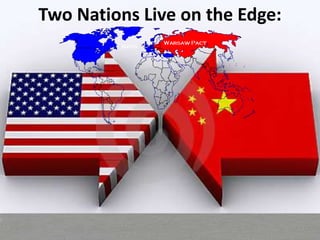
Two Nations Live on the Edge
- 1. Two Nations Live on the Edge:
- 2. Brinkmanship Rules U.S. Policy: • The fear of nuclear attack was a direct result of the Cold War • After the Soviet Union developed its atomic bomb (1949) the two superpowers embarked on an arms race • Race for the H-Bomb pitted U.S. scientists against Soviet scientists (H-Bombs were 67 times more powerful than atomic) Mushroom cloud from the Soviet 50- megaton Tsar Bomba, the largest weapon ever detonated (1961) Operation Castle thermonuclear test, Castle Romeo shot
- 3. Brinkmanship Rules U.S. Policy: • The U.S. won the race on November 1, 1952, the Soviets exploded their first H-bomb less than a year later • The policy of brinkmanship was developed by the administration of President Dwight D. Eisenhower • This policy required the willingness of the U.S. to go to the edge of an all-out-war (use of nuclear weapons)
- 4. Duck and Cover • Under this policy the U.S. trimmed its army and navy and expanded its air force and its nuclear weapons • Americans were under the threat of a nuclear attack (schoolchildren practiced air-raid drills, some families built underground fallout shelters) • Federal Civil Defense Administration (FCDA) Duck & Cover movie poster
- 5. The Cold War Spreads Around the World: CIA • The Central Intelligence Agency (CIA) began carrying out covert operations to weaken or overthrow governments unfriendly to the U.S. • CIA helped to overthrow the Iranian government led by Prime Minister Mohammed Mossadegh (he was unpopular to the West because he proposed to nationalize Iran’s oil fields) • In 1953, the CIA gave several million dollars to pro-American Shah of Iran • The Shah returned to power and turned over control of Iranian oil fields to Western companies
- 6. The Cold War Spreads Around the World: CIA • In 1954, the CIA also took covert actions in Guatemala • The CIA believed that the Guatemalan government was sympathetic to Communists because of an exchange of land (200,000 acres) from American- owned to Guatemalan peasants • The CIA trained an army which invaded Guatemala and removed the government (a military leader became Guatemala’s dictator) Col. Carlos Castillo Armas speaks from the National Palace after the coup.
- 7. The Warsaw Pact: • After the death of Joseph Stalin in 1953 the Cold war thawed temporarily 1. Soviets recognized West Germany 2. Soviets concluded peace treaties with Japan and Austria • By 1955, West Germany was rearming and became a member of NATO • Soviet Union was growing fearful; they established the Warsaw Pact which linked seven Eastern European nations to the Soviet Union The Cold War (1945–90): NATO vs. the Warsaw Pact, the status of forces in 1973
- 8. The Suez War: • In 1955 the U.S., France, and Great Britain agreed to help Egypt finance construction of a dam at Aswan on the Nile River • Gamel Abdel-Nasser, Egypt’s head of government sensed he could play the U.S. and Russia in a bid to get more aid • After Secretary of State John Foster Dulles found out about negotiations between Egypt and the Soviet Union the United States withdrew their offer of a loan
- 9. The Suez War: • Angered, Nasser nationalized the Suez Canal cutting off trade for Great Britain, France, and Israel • The three countries seized the Mediterranean end of the canal rather quickly • The UN stepped in and forced Great Britain, France, and Israel to withdraw-Egypt maintained control of the canal • After the crisis in the Middle East, the United States issued what would become known as the Eisenhower Doctrine: the U.S. would defend any Middle eastern countries from the aggression of a communist nation Nasser returns to cheering crowds in Cairo after announcing the nationalization of the Suez Canal Company, August 1956
- 10. The Eisenhower Doctrine: • The Soviet Union’s prestige in the Middle East rose because of its support for Egypt • To counter this development Eisenhower issued a warning in January 1957 • This warning said that the United States would defend the Middle East against an attack by any communist nation
- 11. The Hungarian Uprisings: • The Soviet Union after World War II dominated Hungary • Imre Nagy, a popular liberal Hungarian Communist leader formed a new government • He called for free elections, denounced the Warsaw Pact, and demanded that all Soviet troops leave Hungary Time's "Man of the Year" for 1956 was the Hungarian Freedom Fighter.
- 12. The Hungarian Uprisings: • The Soviet response was swift- tanks rolled into Hungary and put down the revolt • An estimated 30,000 Hungarians were killed and Nagy was executed • The United States and the U.N. did nothing (Truman Doctrine failed and the Soviets vetoed any U.N. resolutions that condemned actions by the Soviets) Hungarians gather around the head of the toppled Stalin Monument in Budapest
- 13. The Cold War Takes to the Skies: • After Stalin’s death in 1953, Nikita Khrushchev gained power and believed that communism could prevail peacefully by competing with the United States scientifically and economically • The space race was a key area of competition for the Soviets and the Americans • The Soviets struck first by launching Sputnik (a satellite) October 4, 1957; Americans were shocked • Less than a year later after a humiliating launch that blew up, the United States finally launched their first satellite into orbit
- 14. U-2 Downed Over Russian Territory • U-2 spy planes had been flying over Soviet territory since 1957, and the Soviets had been aware of these flights starting in 1958 • A U-2 plane, piloted by Francis Gary Powers, was shot down in 1960 • The U-2 incident caused tension between the U.S. and Soviets